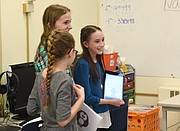Code Girls take on tech challenge
The future tech girls of the Flathead Valley have arrived and they’re prepared to bring their coding game to their first competition.
On Thursday, these Montana Code Girls presented their apps to local venture capitalist Liz Marchi of the Frontier Angel Fund and Devin Holmes, co-founder of Big Sky Code Academy.
“I’m looking for new talent — girl power,” Marchi said with enthusiasm.
The Missoula-based Montana Code Girls is a program of Big Sky Code Academy designed as a free, after-school group to teach coding to girls ages 9 through 19.
Holmes, who himself has a 3-year-old daughter, sees the gap of women in technology.
“I’ve been in tech my whole career and so we know the gender gap is there,” Holmes said.
Holmes, Marchi and Marianne Smith, one of the leaders of the Kalispell chapter of Montana Code Girls, agreed that elementary and middle school is a critical time to get girls interested in science, technology, engineering and math.
“Girls around the ages of 8 to 10, 8 to 12 is really where they start to form their identity, who they are,” Holmes said.
The girls began meeting last fall and in January raced against time to assemble three Technovation Challenge teams consisting of fifth- through seventh-graders from Cayuse Prairie School, Elrod Elementary, home school and Kalispell Middle School.
While people from different countries speak different languages — code is the universal language of the future.
“I think in this age and demographic it’s just a necessary language for the future,” Holmes said.
Although the girls began at ground zero last fall, by Thursday they had apps, business plans and ideas for improvement.
Fifth-graders Elise Suda, Kelsea Bemis and Lillian Lewis created a multiplication app called “Math is the Key.”
The original concept for the app included users winning keys that would open doors to rooms they could decorate. Bemis said the group had to simplify the concept to match their abilities as beginner coders, but they hope to expand as they become more advanced.
“I learned how to rename all the buttons and what components [were needed] to make the app work right,” Lewis said.
On the outset, strings of numbers, letters and characters may appear unappealing. What can result, however, is a bit of a revelation. Suda, for example, discovered that it was pretty exciting making a simple app for the first time.
Design is one way to make coding appealing to this age group, according to Smith. The graphic design appeal hooked fifth-graders Isabelle Ashley, Taylor Pooton and Makayla Davenport who created “Word Keys” a spelling app.
Marchi commented on how the girls challenged themselves through design.
“I love your home screen. I think the owl is awesome — very attractive to the user,” Marchi said. “I’m really impressed with some complicated features to your coding.”
Part of the Technovation Challenge is innovation, solving problems and helping out a community through technology.
In coming up with an app the girls had to do market and competitive analysis while looking at a “future direction,” for each app.
After a heavy winter resulting in roads pockmarked with potholes, seventh-graders Jaclyn Green, Alexandra Houseworth, Hannah Pieri and Lilly Schroeder, saw a clear problem.
“The problem that our app is solving is that a lot of drivers notice potholes in the road, but it’s hard to tell the city and the city doesn’t know about them,” Schroeder said.
The girls read user reviews of existing apps and sought to make a new app with an improved user experience. The result is the “Road Obstacle Reporter,” or “ROR.”
“The driver can turn on the app and just say ‘pothole’ and then it reports that and sends it to the proper authorities,” Green said.
Houseworth demonstrated how the app was used.
“This app allows you to verbally or manually put in an address or location that has some kind of obstacle [such as a dead deer] or pothole,” Houseworth said.
Pieri added, “The ROR map has Google maps linked to it so when a user says ‘pothole’ or ‘ROR’ the app captures the user’s location.”
Marchi offered her feedback on the app noting the usefulness of aggregating data for the city.
“I can see this as being very useful in productivity for the city because then they can see how many were reported, they can see how many were fixed, and it’s a lot more efficient,” Marchi said. “You save the city a lot of money by telling them where all the potholes are rather than them driving around neighborhoods.”
Whether boy or girl — when it comes to learning how to code — there are little to no barriers according to Holmes.
“You don’t have to be 25 with a college degree, or 40, or 50 to build a mobile app, publish it and have viral user adoption,” Holmes said. “You can be 14 years old and do that. The internet is for everybody, not just adults. So to me that’s the exciting stuff. There could be the next founder of a big software company up here in the Flathead sitting in this room.”
For more information email Smith at m.smith@troutmoon.com or visit www.mtcodegirls.org and technovationchallenge.org.
Reporter Hilary Matheson may be reached at 758-4431 or hmatheson@dailyinterlake.com.



